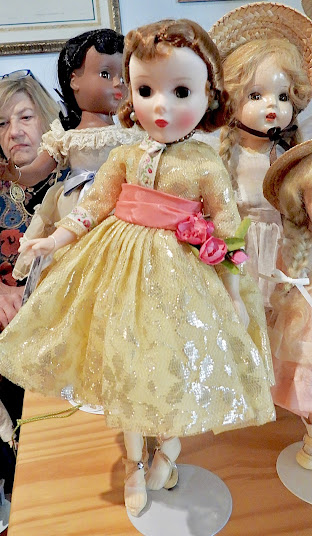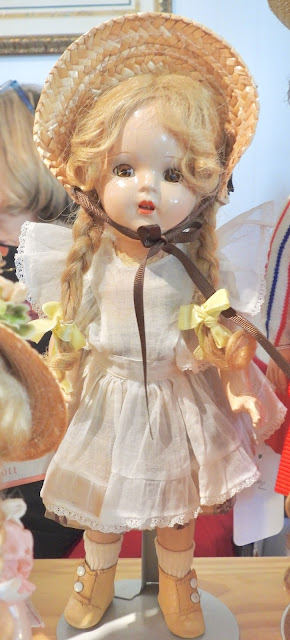Member Jenell Howell did a program on Margaret Mitchell, author of Gone with the Wind, and the Madame Alexander dolls inspired by her book. She gave the club a brief biography of Mitchell, who was born into a wealthy family on November 8, 1900. Her father was a lawyer and her mother was a suffragist. There were a number of Confederate veterans in her family, so she heard lots of stories about the Civil War. When she was six years old, her mother took her on a tour of burned plantations. Mitchell stated that she was 12 years old when she discovered that the Confederacy did not win the Civil War. At 22, Mitchell became a journalist. She injured her ankle at the age of 26 and her husband encouraged her to write a novel while she was recuperating. Ten years later in 1936, Gone with the Wind was published. The novel was an immediate success and won the Pulitzer Prize for fiction. The novel resonated with those who were prosperous in the 1920s and suffering in the Great Depression. In 1939, the Gone with the Wind movie was released. Mitchell was struck by a car on August 11, 1949, as she was walking to the movies with her husband and passed away five days later due to her injuries.
Jenell discussed the novel and the movie. She said that the novel was controversial due to the inherent racism throughout: Black people were portrayed as inferior; Yankee soldiers were portrayed as corrupt and mean; and, freed slaves were portrayed as lacking direction and prone to base instincts. The novel also had a strong female protagonist in Scarlett O’Hara. Themes of resilience, survival, and struggling to maintain an identity amidst societal upheaval are found throughout the novel.
Galley proofs of the novel were provided to Metro-Goldwyn-Mayer, Warner Brothers, and RKO studios prior to the novel’s release, but they all rejected the idea of making a film version. The proofs were also offered to producer David O. Selznick. He initially turned the offer down as he felt it was too much for his small independent company. However, when book was released and sold 176,000 copies in the first three months, Selznick paid $50,000 for the movie rights.
Jenell told the club that Madame Alexander read the novel when it was published in 1936. and immediately contacted Mitchell to secure the rights to make dolls based on the characters in the novel. The first Scarlett dolls produced by Madame Alexander were identified as Southern Girl. Madame Alexander created and sold Scarlett/Southern Girl dolls based on the novel from late 1936 through the release of the movie in 1939. Some of these early Scarletts may have had blue eyes instead of green as the novel did not specify the color of her eyes. Madame Alexander designed Southern belle doll clothes that were later reflected in the movie.
Jenell said that after the movie came out, Alexander created dolls based on Vivien Leigh's portrayal of Scarlett, with green eyes, black hair, and dresses with full skirts. These dolls ranged in size from nine to 21 inches. Jenell showed a wide variety of early composition Madame Alexander Scarletts to the club. She pointed out one that was particularly special. Jenell told the club that she had obtained the doll at the Theriault’s auction of Jane Withers’s dolls. Jane Withers was a contemporary of Shirley Temple and they frequently starred together, with Jane playing the “brat.” Jenell indicated she was thrilled to have been the high bid and was even more thrilled to discover that Jane Withers had signed the back of the doll.
Jenell said that Alexander continued to make dolls based on Scarlett and other characters in the novel and movie for many years. She displayed a hard-plastic Maggie-faced Bonnie Blue doll, representing the daughter of Scarlett and her husband, Rhett Butler; the doll had her original costuming and gold Madame Alexander wrist tag. Jenell stated she had not been able to find any mention of this doll, so it appears that she is rare. In the 1990s, Alexander produced a series of characters using 8-inch Alexander-kins dolls, like this "Mammy."
Jenell noted that other doll companies sought to capitalize on the "Gone with the Wind" craze, creating dolls identified as Southern lady or belle, as Madame Alexander had the rights to create dolls based on the characters in the novel. This doll by Nancy Ann Storybook Dolls is called “Southern Belle.”
Jenell also shared this vintage Vogue Ginny doll she had recently acquired
Other members shared their "Gone with the Wind" character dolls. This Alexander Cissy as Scarlett, dressed in scandalous scarlet, belongs to Jan Irsfeld.
Pam Hardy shared this Alexander Scarlett in a white ruffled gown,
as well as this creation by Avon known as Southern belle.
She also brought this sweet antique bisque German doll.
Sylvia McDonald displayed these Alexander Alexander-kins dolls dressed as Mammy, Scarlett, and Rhett.
Nancy Countryman shared three versions of Scarlett, a Alexander Scarlett portrait doll in a floral gown,
another gowned in green and white,
and an early composition version, as well as
this vinyl Rhett.
David Craig brought this resin ball-jointed doll by JAMIEshow USA, wearing a dress from a Franklin Mint Scarlett doll.
Big thanks to Ann Meier for the pictures and Myrna Loesch for her notes!























.jpeg)
.jpeg)
.jpeg)
.jpeg)
.jpeg)
.jpeg)






.jpeg)
.jpeg)


.jpeg)



.jpeg)